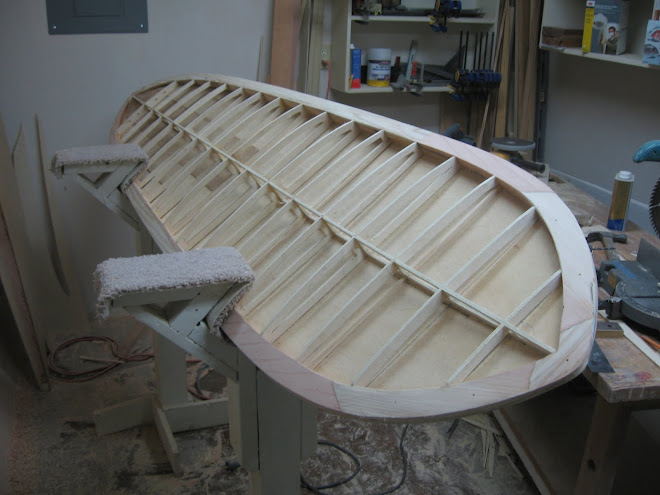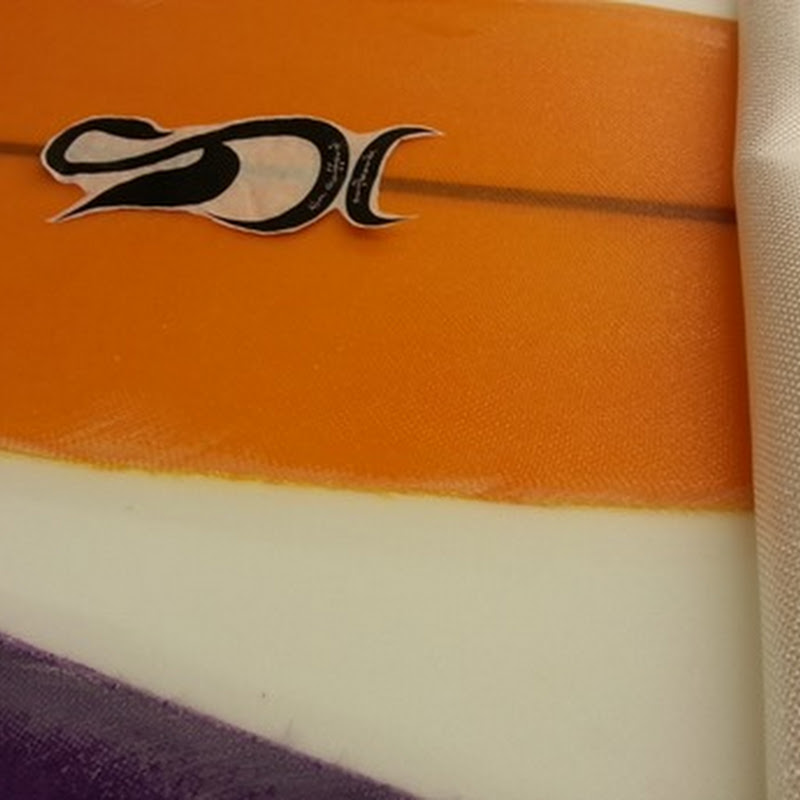 I decided to push the limits on this one - so I built a board with no internal structure. Rails, top deck, bottom deck, that's it. I used redwood for the solid rails, and 5.2mm plywood from Home Depot for the top and bottom. Glassed the whole thing with 4 oz. e-glass and Resin Research epoxy, then glossed with polyester resin.
I decided to push the limits on this one - so I built a board with no internal structure. Rails, top deck, bottom deck, that's it. I used redwood for the solid rails, and 5.2mm plywood from Home Depot for the top and bottom. Glassed the whole thing with 4 oz. e-glass and Resin Research epoxy, then glossed with polyester resin.Right now its a single fin, but I plan on adding sidebites at some point. First ride report: rides solid - easy standup, turns smooth and responsive, trims well, and doesn't show any signs of riding differently because of being completely hollow. Hope to get it into some more waves soon!




This was really just an attempt to utilize the inherent qualities of the plywood to create the design. Meaning the spring angle of the rails combined with the flex of the plywood dictates the deck dome and foil. No computer drawn cross-sections, no tedious cutting ribs, stringer, etc. Rough-shape the rails, glue and clamp the plywood, finish shaping the rails, that's the surfboard, glass it and ride it.
My intent also was to see just how much interior structure is needed, no way to know unless you start with none, so that's what I did. I wanted to challenge some of the assumptions that dictate wood board "fishbones" structure.
Here are some of the comments my build inspired from the internet:
Nice work Huck,
Have you considered just placing a few small blocks between your skins, rather than having a complete void ? Would it work at say 18" centers just to give it some additional strength.
Also maybe the addition of an extra layer of cloth in your lam to compensate for no ribs. Just a thought, i know we do get these from time to time.
-------------
Huck, for heaven's sake, put us out of our misery and build a nice "normal" board using your original and practical method, nice light 4 oz glass job like you do..... and, for f#*k's sake.........DON'T BLOODY PAINT IT!!
-------------
By the way bottom skins which move in and out independently as described don't promote beneficial flex instead they do what is called 'oil canning' . I've experienced it, both on yachts and surfboards and it slows them down while reducing control. . . the very worst of both worlds.
Personally I think that you are barking up a wrong tree with the completely hollow idea. Either the board will oil can or if it is stiff enough not to, will be extremely rigid.
Also completely hollow boards usually rely on performance killing dome in the deck in order to get sufficient skin rigidity to support the rider
They also reduce the direct contact the rider has with the water and the surfboard hull.
The deck and bottom need to be connected.
----------------
the biggest question mark for me is with this is... natural twisting, that might be the double edged sword. lying on the beach, it torque into a cruel picassolike facsimile of yer former creation..lets hope not,though!


































.jpg)












I saw some more pictures of this board on the forum and had a few questions. Glueing the plywood to the rails like you did, did you have any problems with the plywood splintering or revealing voids as you shaped the rails and it took the edge of the plywood through the different layers? Also you'd mentioned that you wet the plywood before bending it. Does it matter if it is not marine grade plywood? How much did you wet it and if it is not marine plywood then is there a possibility that the plys could come apart?
ReplyDeleteThanks for your thoughts
Chris
driftwoodsurfboards@yahoo.com